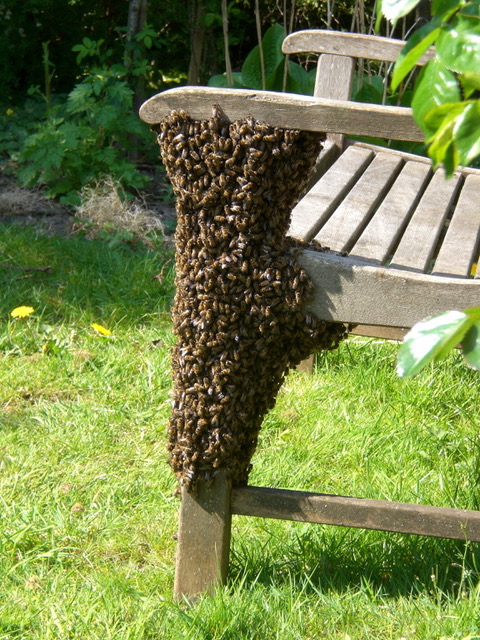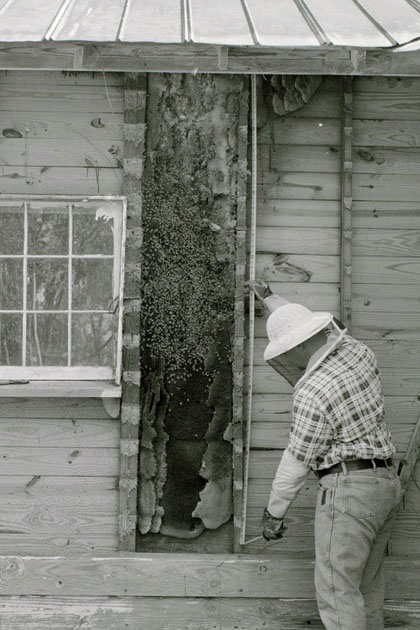This circular is for property owners who have unwanted honey bee swarms on their lands or colonies nesting inside walls. It explains these natural processes and gives options for dealing with them.
- The Value of Honey Bees
- What Is a Honey Bee Swarm?
- Options for Dealing with Swarms
- Bee Colonies Inside Walls
The Value of Honey Bees
Honey bees are one of the most beneficial of all insects. Honey is humanity's oldest sweet, and beeswax was the first plastic. Today, honey bees provide these and other valuable hive products. In addition, thousands of beekeepers in the United States keep bees for fun and profit.
Honey bees are important pollinators of almonds, apples, blackberries, blueberries, cantaloupes, cranberries, cucumbers, forage crops, kiwifruit, squash, and watermelons. The annual contribution of honey bees to U.S. food production is more than $14 million. Declining bee numbers in recent years, sometimes referred to as Colony Collapse Disorder (CCD), have heightened our concern about conserving these important pollinators.
What Is a Honey Bee Swarm?
Honey bee colonies reproduce by a process called swarming. During mid-winter, the queen begins laying eggs and the colony population grows. By spring, the nest is congested with many new bees. The colony raises a new queen and the old queen flies away accompanied by more than half the bees.

This flying swarm temporarily clusters on an object, such as a tree branch, while scout bees search for a permanent nest site. A hanging swarm may assume any shape, depending on the surface on which it is clustered. Most hanging swarms are round or oval, about the size of a basketball, and dark brown.
Swarms in the clustered stage are relatively gentle, and the risk of stings is low. Nevertheless, treat swarms with caution. A swarm usually relocates to a permanent nest—a hollow tree, abandoned beekeeper's hive, or inside a hollow wall—within 24 hours.
Options for Dealing with Swarms
If a honey bee swarm lands on your property:
- Do not disturb it. Keep pedestrians, children and pets away from the swarm.
- If the swarm is safely located away from animals and people, you should wait for it to fly away on its own.
- If the swarm poses a real risk to people or animals, consider finding a local beekeeper who will remove it. However, not all beekeepers collect swarms, and some may charge a fee for this service. Your county Extension agent can refer you to local beekeepers who collect swarms.
Bee Colonies Inside Walls

Wall voids are attractive to honey bee swarms seeking permanent nesting sites. This is especially true if the cavity has had bees in it before. To avoid this problem, caulk potential entry sites such as knot holes, gaps in siding, and openings around plumbing or electric wires. If ventilation is necessary around the openings, cover them with window screen.
Honey bees in walls can be a problem for the following reasons:
- They pose a sting hazard if their hive entrance is near human or pet traffic.
- They may trouble people indoors with the sound of their buzzing.
- If the colony dies, its beeswax combs are no longer ventilated by fanning bees. The combs may melt and stain interior walls with honey and wax.
If you discover a bee colony nesting inside a wall, here are your options:
- In some cases, bees and people cohabit with no problem for years. If the nest's entry point is far away from human and pet traffic, such as the peak of a roof, consider a leave-alone approach.
- If the bee flyway is near human or animal traffic it may be a more serious situation. If you see bees flying back and forth from a gap in the walls of your house or other structure, this is a sign that a bee colony has set up home inside the hollow. A confirming sign is if you see bees returning to the nest with yellow pollen on their legs, which signals that they are collecting plant pollen to feed their developing larvae.
- Bees inside a hollow wall should only be removed by a honey bee control and removal specialist licensed by the state of Georgia. These experts operate under state licensing supervised by the Georgia Department of Agriculture Structural Pest Control Commission and possess the necessary skill set to open a wall void, humanely remove the bees, comb and all, and close the void, sealing it to prevent future entry of swarms. THIS IS NOT A JOB FOR AN AMATEUR. The specialist will expose the nest by removing the siding or necessary timbers, vacuuming the bees off each wax comb. He or she continues cutting away, vacuuming, and removing each comb in succession until all the bees and combs are removed. The void is then sealed off. Depending on the nest’s location, the technician may need to work either inside or outside the structure.
- The morning after the work is done, it is not unusual to find a few worker bees on the outside surface where the nest entrance used to be. These individuals are disoriented, pose a low sting risk, and will die or relocate within a day or so. Bee removal specialists typically re-house the bees in standard bee hives and sell or manage them for pollination or honey production.
Remember, honey bees are beneficial insects and are not aggressive. However, they will defend their nest if they perceive a threat. If you encounter flying honey bees, calmly walk away from them and never swat them. Swatting only threatens them and increases the chance of a sting. Your county Extension agent or local beekeeping association can help you with any questions about honey bees.
Status and Revision History
Published on Jul 01, 1994
In Review for Minor Revisions on Mar 12, 2009
Published on Mar 17, 2010
Published with Minor Revisions on Jul 18, 2014
Published with Minor Revisions on Jul 24, 2024


























































